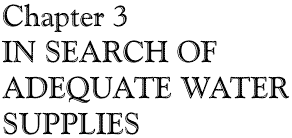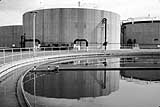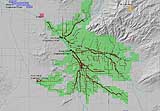
| ch. 3, pp. 23 - 25 |
Some municipal providers with CAP contracts, such as those in the Green Valley area, cannot use their allocations directly because the canal does not reach them. To better service them, a group of water users in the Upper Santa Cruz basin studied the possibility of extending the CAP canal from its current end point near Interstate 19 and Pima Mine Road south of Tucson to the Green Valley/Sahuarita area. In a 1998 study, the group identified possible alignments for the canal and estimated costs. Other municipal providers who cannot use their allocations directly plan to recharge their CAP water to offset some of their groundwater pumping. Treated Effluent
Treated effluent is water that has been used in homes and businesses and then collected by the sewage system and treated at a wastewater treatment plant, for various water uses. Some 85 to 90 percent of households in the Tucson metropolitan area are connected to the central sewage system. Effluent is considered a renewable supply because it extends our stored groundwater supply. Generally as population increases, so does the supply of effluent. Total treated effluent production from wastewater treatment plants in the Tucson AMA (TAMA) was 70,100 acre-feet in 1996, or approximately 63 million gallons per day (mgd). Almost all the effluent came from the Ina and Roger road treatment plants. Nine other small treatment facilities are located in Pima County, and an estimated 11 percent of single family residences have septic tanks. Total effluent flows in Pima County are projected to reach 103 mgd, or 115,760 acre-feet, by the year 2025. Wastewater delivered to the Ina and Roger road treatment plants undergoes primary and secondary treatment processes at treatment facilities to meet state and EPA water quality standards. Of the approximately 69,400 acre-feet of secondary-treated effluent produced at these plants in 1995, approximately 4 percent was delivered directly to farms and another 2 percent was delivered directly to turf facilities such as golf courses. Another 13 percent was sent to Tucson Water’s reclaimed water facilities, located next to the Roger Road Wastewater Treatment Facility for additional treatment involving filtration through sand filters or soil and additional disinfection. Reclaimed water then is delivered for use or is recharged at the Sweetwater Underground Storage and Recovery Facility, to be pumped out when needed to meet peak irrigation demands during summer. (See Chapter 5 for more information on the use of effluent.) The remaining 84 percent of the effluent is released into the Santa Cruz River channel. Approximately 96 percent of released discharges eventually infiltrates the river channel to the underlying aquifer within TAMA. The remaining 4 percent evaporates or is used by riparian vegetation.
The Regional Effluent Planning Partnership has listed 20 effluent projects and potential alternatives as of January 1999 (See Appendix B). Of these 20 projects, three presently exist, seven are in the process of being built and ten are proposed for the future. Two of the proposed projects would create recharge credits for the existing discharge to the Santa Cruz River. If these projects are approved, the state would grant credits for 50 percent of the amount of effluent recharged. These credits could be used to allow groundwater pumping elsewhere in the TAMA, partially nullifying the contribution of the existing effluent discharges towards safe yield calculations for TAMA. An assessment also is currently being conducted to determine potential impacts of any changes in effluent discharge on the riparian area downstream of the wastewater treatment plants. At least seven constraints may limit full use of effluent. None of these constraints are insurmountable barriers; yet they must be taken into consideration when making plans for dealing with effluent. They include:
|


